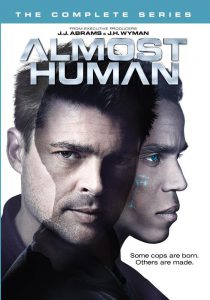I decided to wait until after the second episode to give my impressions of “Almost Human” (7 p.m. Central Mondays on Fox), because Sunday’s pilot was simultaneously confusing and lacking in new (or even new-ish) ideas. Fox’s latest attempt at an expensive sci-fi franchise — following the likes of the quickly canceled “Terra Nova” and the longer-running “Fringe” — starts with a voiceover that says the crime rate has increased by 400 percent between now and 2048, when the series is set.
Then in a showdown with criminals in a big-city ally, the hero, Detective John Kennex (Karl Urban, Bones in the new “Star Trek” films) gets his leg blown off and is knocked unconscious by an explosion. “Almost Human” follows his personal journey from that point forward, forgetting to provide context. Why is the crime rate up 400 percent — is it because there is an increase in crime as it is defined today, or because there’s an increase in things the government defines as crime? And, for that matter, what are the crimes, goals, etc., of the criminals John faces off with?
Frustratingly, we don’t get much context in the pilot episode. “Almost Human” — admittedly, nicely designed with some shots of neon cityscapes and floating computer screens and human-like androids — seems to be a logical extrapolation 35 years into the future. So unlike, say, “Dark Angel,” where an EMP turned America into a third-world country overnight, there’s no dystopia-forming big event that “Almost Human” takes place in the wake of. There’s no collapse of the dollar, so presumably citizens were able to peacefully rein in government spending at the voting booth (quite an accomplishment, that). (We haven’t seen any characters make a monetary transaction yet.) But at the same time, the police department seems very well funded, judging by the fact that it has android officers decommissioned and gathering dust in storage.
As with most mainstream shows, the cops are unambiguously good guys on “Almost Human” — albeit flawed, natch. John, in addition to limping around on his hastily installed (and, interestingly, black-market) synthetic leg, misses his girlfriend, who may have disappeared because she was just pretending to love him and actually works for the so-far-ill-defined criminal enterprise. Also, his partner died in the show’s opening raid. John’s new partner, Dorian (Michael Ealy) is one of those decommissioned synthetics that is programmed with intuition in addition to the fact-based analysis of the newer models.
As such, we get to “Almost Human’s” pitch, and the title’s double meaning: A human who’s robotically going through the motions partners with an android who is human in every way except actual fact.
The second episode, “Skin,” is a second-rate exploration of the type of thing “Fringe” might’ve explored in its early seasons (indeed, “Almost Human” creator J.H. Wyman is a “Fringe” veteran): Skirting regulations, a company is building sex-bots using actual women’s skin, because it makes the bots seem more real to their clients. It’s a fairly fun episode, with the banter and chemistry between John and Dorian starting to spark, like when Dorian (scanners always alert) off-handedly notes that John’s pulse is elevated as they investigate a showroom of sex-bots.

Adding some sex appeal to the show’s roster is “Friday Night Lights’ “ Minka Kelly as dispatcher Stahl, who maybe has a thing for John. And adding humor is UK “Office” veteran Mackenzie Crook as the precinct’s resident scientist (sort of like a coroner, but he does lots of other stuff, too). He’s pretty funny in the scene where he talks too much while plugging his computer interface into a sex-bot.
So, yeah, there’s potential here, and there are brief hints of style, like when John and Dorian are sitting on a restaurant patio in the rain in the pilot episode. But, unfortunately, “Almost Human” is so far a bit too slick, simple and calculated. It’s no “Blade Runner,” where you can wallow in the neon-lit futuristic slums, nor is it even “Dark Angel.”
This future of “Almost Human” is different, but not all that compellingly different. The story ideas seem solid enough that I’ll stick with the show for a bit, but I’d just as soon have “Fringe” still be on the air (or “Terra Nova,” or “Dollhouse,” or “Terminator: The Sarah Connor Chronicles” … you get the idea). Most irritating of all, there’s no sense of why or how the crime rate went up 400 percent, or why it matters for the purpose of this show. I’d like to think the writers are going to dole out the explanations in intriguing fashion, but it’s more likely that “Almost Human” isn’t going to go there, because it’s shallower and less daring than it wants us to believe.

